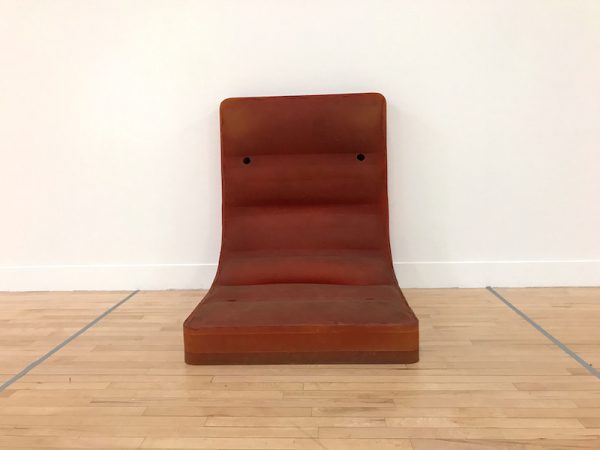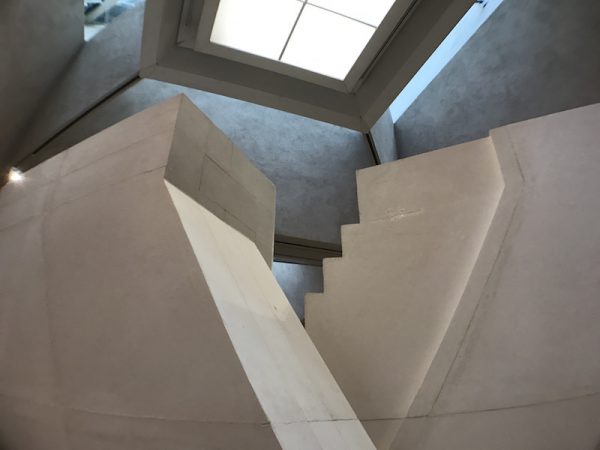Trying to get hold of Rachel Whiteread to talk about her new exhibition at Tate Britain, her largest to date, is rather like attempting to gain an audience at the White House. The Tate only gives me a strict half an hour but she walks me round the show before it opens as the technicians beaver away, happy that I’m familiar with her work and knew her late mother Pat, a little, herself a serious artist. She is unpretentious and friendly and when we meet, dressed casually in ubiquitous art black. She’s naturally reticent – blushing a little – when I say I know she hates talking about her work. But there’s also a steely professionalism. When I apologise for taking notes and not using a tape recorder she says: “Oh that’s fine. I write things down too.”
I first came across Rachel Whiteread’s work in the early 1990s. It was intelligent, quiet and thoughtful, at odds with the razzmatazz of many of her contemporaries, the other Young British Artists shocking their way into visibility. In contrast, she was casting the inside of wardrobes, dressing tables, and hot water bottles, that looked like the headless torsos of dead babies. Dreamy, ruminative and poetic her work explored how physical objects acted as Proustian catalysts to retrieve what is so often only half remembered, what lurks just below the plimsol line of consciousness. And then there was House, created in 1993 in a small park in the East End of London, which existed for a mere 80 days. A caste of the last surviving end-of-terrace that was about to be demolished, home of Sydney Gale a former docker, which was a direct connection to an older, disappearing way of life. Using the building as a mould, Whiteread imprinted fireplaces, cornices, and cupboards to create a stark mausoleum that ensnared the ghosts of its past inhabitants like flies trapped in amber. That year she was also the first woman to win the Turner Prize and a few years later made Embankment constructed of 14,000 polyethylene cases of cardboard boxes stacked, one on top of the other, that filled the Turbine Hall of Tate Modern and spoke, obliquely, of global warming. And then there was her controversial sculpture commissioned for the Holocaust Memorial 2000, in Vienna.

We begin our conversation at the vitrine outside the main gallery which she describes as “the amalgamation of the inside of my head”. It contains a magpie collection: bits of House, note books full of lists, light switches both caste and actual, objects that her children have made or that she’s just found. It is, I suggest, a sort of ‘thinking laboratory’. ‘Exactly’, she says.
As we approach her early work, Shallow Breath, 1988, a pallid mattress made from plaster and polystyrene that leans like a sagging body against the wall – part corpse, part death bed, part Dadaist object – and her 1988 Closet and Mantle, I suggest that, as a poet, I respond strongly to her work because she has a rare understanding of the use metaphor. “Mmm,” she says” I don’t want to say too much, give too much away”. And I’m worried that she’s going to shut down and only tell me things I already know. But then she smiles and says: “of course, you’re right, but I stopped giving things titles and started calling them Untitled because I didn’t want to be too poetic or prescriptive”. It’s hard, though, not to read her Untitled (Square Sink) 1990 as some sort of art brut baptismal font or Untitled (Bath) 1990 as a sarcophagus from some ancient civilisation.

I ask who’ve been her influences? “Well, when I was at art school I was taught by Phyllida Barlow, Antony Gormley, and Alison Wilding. I started as a painter and wasn’t really looking at British art as much as the Americans.” And it’s not difficult, as we walk round the gallery, to notice the underlying influence of Carl Andre and Donald Judd. But where they were primarily interested in the formal language of minimalism, she’s been called ‘the minimalist with a heart’. Not a label she particularly likes. “But it’s true that art, for me, is about making work with emotion. I’m really quite an emotional person.” Over and over she returns to the domestic object: stained mattresses, hot water bottles, tables. The small incidental items of everyday life that have embedded within them Freud’s notion of unheimlich or the uncanny, a concept that describes what is at once familiar and ‘homely’, yet also strange and secret.
Although there’s an apparent absence of colour within the show, actually the non-colours are very specific and hard won. “I have materials invented for me. I phone up companies and badger them. Say I want something that looks like the colour of the first piss in the morning. I wanted this piece here”, she says pointing at Untitled (White Slab) 1994/2017, “to be the colour of spunk.” The tongue-like form angled against the wall looks like a waxy mortician’s slab. I ask if she agrees with T.S. Elliot that there are no other real subjects for poetry and art other than the “brass facts” of “birth copulation and death.” “Well”, she says, “we’re on this planet for whatever reason and I’m interested in humanity. So, broadly yes. Though I wouldn’t have put quite so bluntly. Actually, the truth is, I’d no idea how this show would come together. But I’m pleased to find that I’ve managed to sustain a commonality of language over the years. It’s been nerve racking. It’s 30s years’ work. But it’s been a pleasure to put together. I wasn’t sure it would be”

I ask if she thinks of herself as part of the Romantic tradition, in the sense that Romanticism emphasised the individual and the subjective, the irrational and the imaginative, the personal and the emotional over the rationality of Apollonian Classicism. She’s silent for a moment, then says: “You know I’ve never thought of myself as a Romantic. But, yes, I suppose I am. For me, art is fundamental to culture and politics, to how we live our lives. It acts as a barometer of history and mirrors the horrors of what’s going on. Though I don’t think it can actually change the world.”
As we move across the room we come to a series of shelves covered in uncharacteristically colourful objects. Some of them look like boxes of Kleenex or painted toilet tissue tubes, the sort children bring home from playschool. “This work was influenced by having children. That’s why there’s more colour.” “Did they help you paint the tubes?” I ask. She laughs. “I love my children very much but I don’t actually get them to make my work! They’re caste even though they look like cardboard.”
There’s a restrained emotional power to much of her work. Untitled (Book Corridors) 1997-8 is a precursor to the Holocaust Memorial, commissioned for Vienna’s Juednplatz, in 2000. Unlike other famous libraries such as Alexandria and Ephesus or Borges fictional bibliographical labyrinthine, all of which were filled with life-enhancing knowledge, this is a tomb where all language has been silenced. As we move on to Untitled (Stairs) 2001 and Untitled floor (Thirty-six)2002, she explains that these were taken from her previous home, an old synagogue in the East End. The stairs, like a great pair of white plaster wings that make me think of the fall of Icarus, lead nowhere. She caste them before the family moved in. She must, I suggest, have a very understanding husband. “Yes”, she says, “he’s very supportive.”

The final works we look at together are the newest: Wall (Three Windows), Roof (Beams I and II) and Wall (Apex) are all made from papier-mâché. Hung on the wall these works look like speckled marble, a cross between a contemporary flatpack kit and the found fragments from an ancient Roman site. In fact, she tells me, the papier-mâché was made by pulping all the debris she couldn’t take with her when she recently moved from the synagogue back to north London. Objects and memories given a new life as sculpture. And then, before we can move onto the next piece, she’s whisked away by her Tate minder. My time is up, even though we are deep in conversation. There is still so much I want to ask. About the large-scale early installation Untitled (One Hundred Spaces)1995 caste from the underside of chairs that sits in the Duveen Galleries like a row of old fashioned coloured jelly cubes. Or the new work in the garden outside made especially for this exhibition, Chicken Shed 2017, caste from a Norfolk shed owned by a friend and which continues her recent focus on sheds, huts and cabins, places of enclosure that she refers to as her ‘shy sculptures’. There’s also the selection of sculptures that she’s chosen by artists such as Anthony Caro, Richard Deacon and Sarah Lucas, taken from the Tate’s collection, to complement her show. But before I can ask anything else she’s hurried away to her next interview. For a very private artist, she’s suddenly being asked to do a lot of talking.

Words: Sue Hubbard Photos P C Robinson © Artlyst 2017
Sue Hubbard is an award-winning poet, novelist and freelance art critic. Her new novel, Rainsongs, is due from Duckworth in January
Rachel Whiteread. Tate Britain until 21 January 2018 Visit Here

